Social Upheaval in Britain After the Industrial Revolution: An Essay
VerifiedAdded on 2021/04/17
|12
|3127
|202
Essay
AI Summary
This essay critically evaluates the social upheaval in Britain following the Industrial Revolution, a period considered a turning point in human history. It examines the drastic changes in social life, the shift from agricultural dominance, and the rise of urbanization. The essay explores the emergence of new economic and philosophical ideologies, and the impact on class structures, particularly the exploitation of women and children in factories. It highlights the benefits like increased material wealth and opportunities for women, while also acknowledging the harsh conditions faced by the new working class. The essay discusses the transformation of family structures, the incorporation of child and women labor, and the lack of worker protections, providing a comprehensive overview of the social consequences of this transformative period.
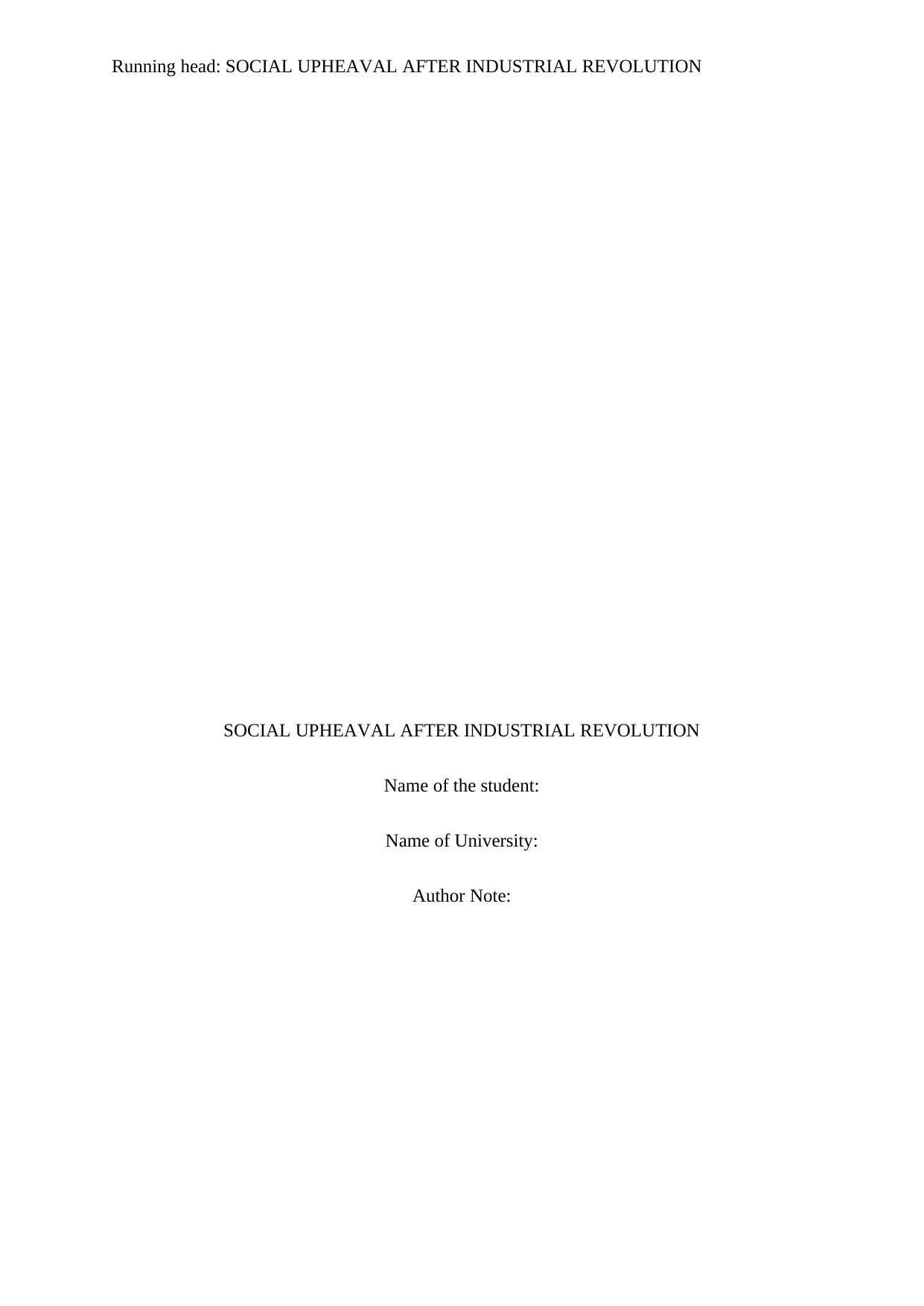
Running head: SOCIAL UPHEAVAL AFTER INDUSTRIAL REVOLUTION
SOCIAL UPHEAVAL AFTER INDUSTRIAL REVOLUTION
Name of the student:
Name of University:
Author Note:
SOCIAL UPHEAVAL AFTER INDUSTRIAL REVOLUTION
Name of the student:
Name of University:
Author Note:
Paraphrase This Document
Need a fresh take? Get an instant paraphrase of this document with our AI Paraphraser
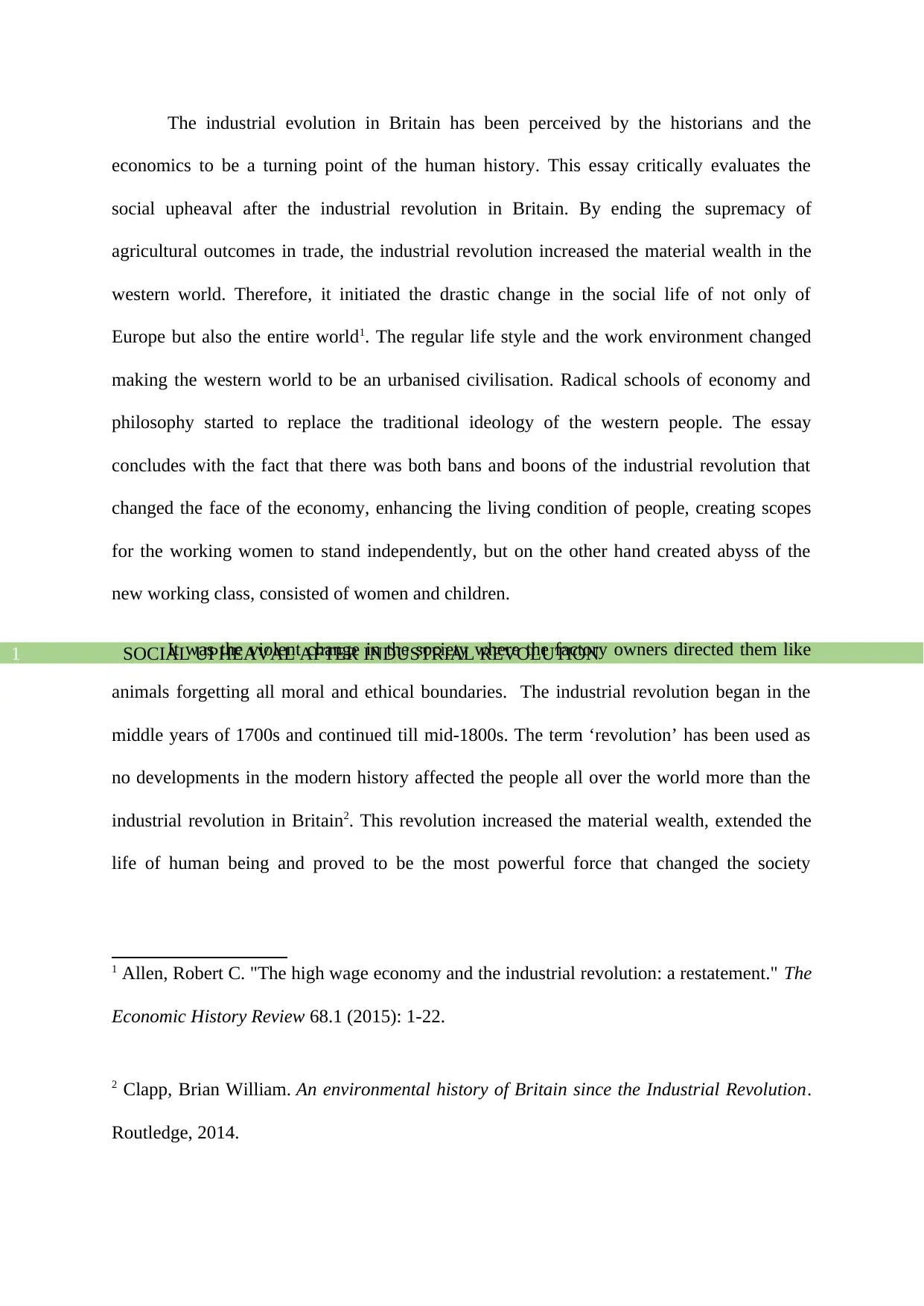
SOCIAL UPHEAVAL AFTER INDUSTRIAL REVOLUTION1
The industrial evolution in Britain has been perceived by the historians and the
economics to be a turning point of the human history. This essay critically evaluates the
social upheaval after the industrial revolution in Britain. By ending the supremacy of
agricultural outcomes in trade, the industrial revolution increased the material wealth in the
western world. Therefore, it initiated the drastic change in the social life of not only of
Europe but also the entire world1. The regular life style and the work environment changed
making the western world to be an urbanised civilisation. Radical schools of economy and
philosophy started to replace the traditional ideology of the western people. The essay
concludes with the fact that there was both bans and boons of the industrial revolution that
changed the face of the economy, enhancing the living condition of people, creating scopes
for the working women to stand independently, but on the other hand created abyss of the
new working class, consisted of women and children.
It was the violent change in the society where the factory owners directed them like
animals forgetting all moral and ethical boundaries. The industrial revolution began in the
middle years of 1700s and continued till mid-1800s. The term ‘revolution’ has been used as
no developments in the modern history affected the people all over the world more than the
industrial revolution in Britain2. This revolution increased the material wealth, extended the
life of human being and proved to be the most powerful force that changed the society
1 Allen, Robert C. "The high wage economy and the industrial revolution: a restatement." The
Economic History Review 68.1 (2015): 1-22.
2 Clapp, Brian William. An environmental history of Britain since the Industrial Revolution.
Routledge, 2014.
The industrial evolution in Britain has been perceived by the historians and the
economics to be a turning point of the human history. This essay critically evaluates the
social upheaval after the industrial revolution in Britain. By ending the supremacy of
agricultural outcomes in trade, the industrial revolution increased the material wealth in the
western world. Therefore, it initiated the drastic change in the social life of not only of
Europe but also the entire world1. The regular life style and the work environment changed
making the western world to be an urbanised civilisation. Radical schools of economy and
philosophy started to replace the traditional ideology of the western people. The essay
concludes with the fact that there was both bans and boons of the industrial revolution that
changed the face of the economy, enhancing the living condition of people, creating scopes
for the working women to stand independently, but on the other hand created abyss of the
new working class, consisted of women and children.
It was the violent change in the society where the factory owners directed them like
animals forgetting all moral and ethical boundaries. The industrial revolution began in the
middle years of 1700s and continued till mid-1800s. The term ‘revolution’ has been used as
no developments in the modern history affected the people all over the world more than the
industrial revolution in Britain2. This revolution increased the material wealth, extended the
life of human being and proved to be the most powerful force that changed the society
1 Allen, Robert C. "The high wage economy and the industrial revolution: a restatement." The
Economic History Review 68.1 (2015): 1-22.
2 Clapp, Brian William. An environmental history of Britain since the Industrial Revolution.
Routledge, 2014.
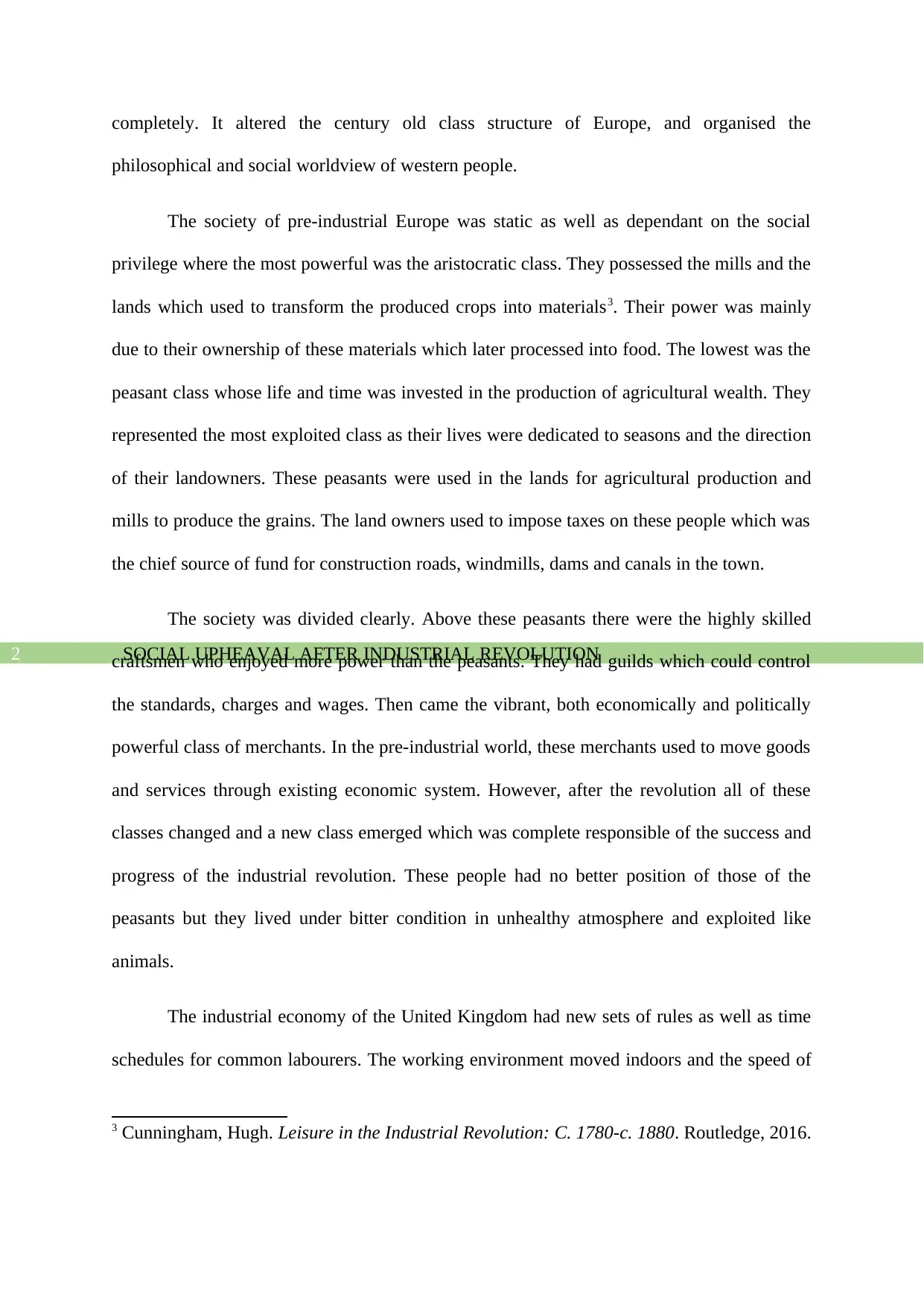
SOCIAL UPHEAVAL AFTER INDUSTRIAL REVOLUTION2
completely. It altered the century old class structure of Europe, and organised the
philosophical and social worldview of western people.
The society of pre-industrial Europe was static as well as dependant on the social
privilege where the most powerful was the aristocratic class. They possessed the mills and the
lands which used to transform the produced crops into materials3. Their power was mainly
due to their ownership of these materials which later processed into food. The lowest was the
peasant class whose life and time was invested in the production of agricultural wealth. They
represented the most exploited class as their lives were dedicated to seasons and the direction
of their landowners. These peasants were used in the lands for agricultural production and
mills to produce the grains. The land owners used to impose taxes on these people which was
the chief source of fund for construction roads, windmills, dams and canals in the town.
The society was divided clearly. Above these peasants there were the highly skilled
craftsmen who enjoyed more power than the peasants. They had guilds which could control
the standards, charges and wages. Then came the vibrant, both economically and politically
powerful class of merchants. In the pre-industrial world, these merchants used to move goods
and services through existing economic system. However, after the revolution all of these
classes changed and a new class emerged which was complete responsible of the success and
progress of the industrial revolution. These people had no better position of those of the
peasants but they lived under bitter condition in unhealthy atmosphere and exploited like
animals.
The industrial economy of the United Kingdom had new sets of rules as well as time
schedules for common labourers. The working environment moved indoors and the speed of
3 Cunningham, Hugh. Leisure in the Industrial Revolution: C. 1780-c. 1880. Routledge, 2016.
completely. It altered the century old class structure of Europe, and organised the
philosophical and social worldview of western people.
The society of pre-industrial Europe was static as well as dependant on the social
privilege where the most powerful was the aristocratic class. They possessed the mills and the
lands which used to transform the produced crops into materials3. Their power was mainly
due to their ownership of these materials which later processed into food. The lowest was the
peasant class whose life and time was invested in the production of agricultural wealth. They
represented the most exploited class as their lives were dedicated to seasons and the direction
of their landowners. These peasants were used in the lands for agricultural production and
mills to produce the grains. The land owners used to impose taxes on these people which was
the chief source of fund for construction roads, windmills, dams and canals in the town.
The society was divided clearly. Above these peasants there were the highly skilled
craftsmen who enjoyed more power than the peasants. They had guilds which could control
the standards, charges and wages. Then came the vibrant, both economically and politically
powerful class of merchants. In the pre-industrial world, these merchants used to move goods
and services through existing economic system. However, after the revolution all of these
classes changed and a new class emerged which was complete responsible of the success and
progress of the industrial revolution. These people had no better position of those of the
peasants but they lived under bitter condition in unhealthy atmosphere and exploited like
animals.
The industrial economy of the United Kingdom had new sets of rules as well as time
schedules for common labourers. The working environment moved indoors and the speed of
3 Cunningham, Hugh. Leisure in the Industrial Revolution: C. 1780-c. 1880. Routledge, 2016.
⊘ This is a preview!⊘
Do you want full access?
Subscribe today to unlock all pages.

Trusted by 1+ million students worldwide
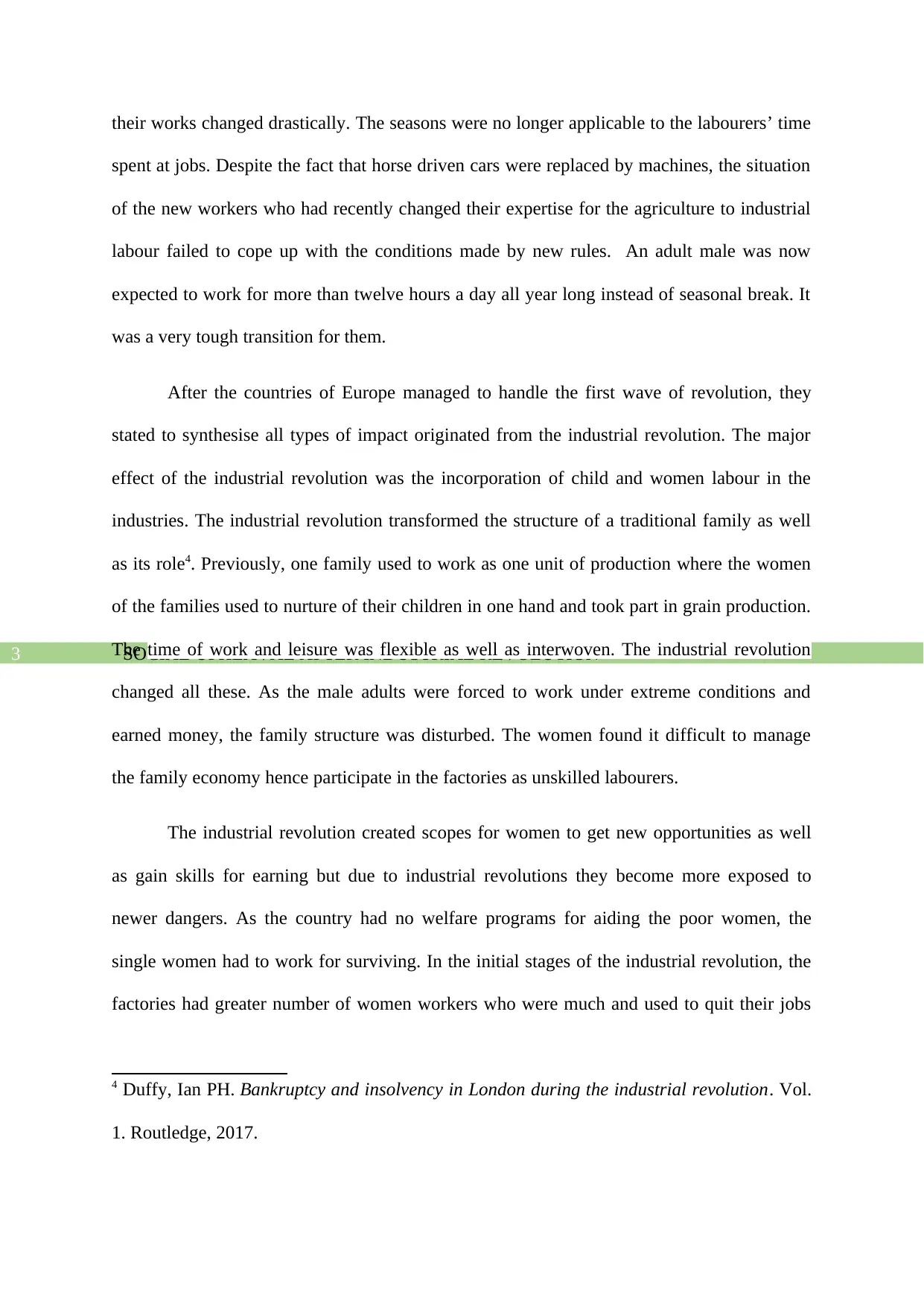
SOCIAL UPHEAVAL AFTER INDUSTRIAL REVOLUTION3
their works changed drastically. The seasons were no longer applicable to the labourers’ time
spent at jobs. Despite the fact that horse driven cars were replaced by machines, the situation
of the new workers who had recently changed their expertise for the agriculture to industrial
labour failed to cope up with the conditions made by new rules. An adult male was now
expected to work for more than twelve hours a day all year long instead of seasonal break. It
was a very tough transition for them.
After the countries of Europe managed to handle the first wave of revolution, they
stated to synthesise all types of impact originated from the industrial revolution. The major
effect of the industrial revolution was the incorporation of child and women labour in the
industries. The industrial revolution transformed the structure of a traditional family as well
as its role4. Previously, one family used to work as one unit of production where the women
of the families used to nurture of their children in one hand and took part in grain production.
The time of work and leisure was flexible as well as interwoven. The industrial revolution
changed all these. As the male adults were forced to work under extreme conditions and
earned money, the family structure was disturbed. The women found it difficult to manage
the family economy hence participate in the factories as unskilled labourers.
The industrial revolution created scopes for women to get new opportunities as well
as gain skills for earning but due to industrial revolutions they become more exposed to
newer dangers. As the country had no welfare programs for aiding the poor women, the
single women had to work for surviving. In the initial stages of the industrial revolution, the
factories had greater number of women workers who were much and used to quit their jobs
4 Duffy, Ian PH. Bankruptcy and insolvency in London during the industrial revolution. Vol.
1. Routledge, 2017.
their works changed drastically. The seasons were no longer applicable to the labourers’ time
spent at jobs. Despite the fact that horse driven cars were replaced by machines, the situation
of the new workers who had recently changed their expertise for the agriculture to industrial
labour failed to cope up with the conditions made by new rules. An adult male was now
expected to work for more than twelve hours a day all year long instead of seasonal break. It
was a very tough transition for them.
After the countries of Europe managed to handle the first wave of revolution, they
stated to synthesise all types of impact originated from the industrial revolution. The major
effect of the industrial revolution was the incorporation of child and women labour in the
industries. The industrial revolution transformed the structure of a traditional family as well
as its role4. Previously, one family used to work as one unit of production where the women
of the families used to nurture of their children in one hand and took part in grain production.
The time of work and leisure was flexible as well as interwoven. The industrial revolution
changed all these. As the male adults were forced to work under extreme conditions and
earned money, the family structure was disturbed. The women found it difficult to manage
the family economy hence participate in the factories as unskilled labourers.
The industrial revolution created scopes for women to get new opportunities as well
as gain skills for earning but due to industrial revolutions they become more exposed to
newer dangers. As the country had no welfare programs for aiding the poor women, the
single women had to work for surviving. In the initial stages of the industrial revolution, the
factories had greater number of women workers who were much and used to quit their jobs
4 Duffy, Ian PH. Bankruptcy and insolvency in London during the industrial revolution. Vol.
1. Routledge, 2017.
Paraphrase This Document
Need a fresh take? Get an instant paraphrase of this document with our AI Paraphraser
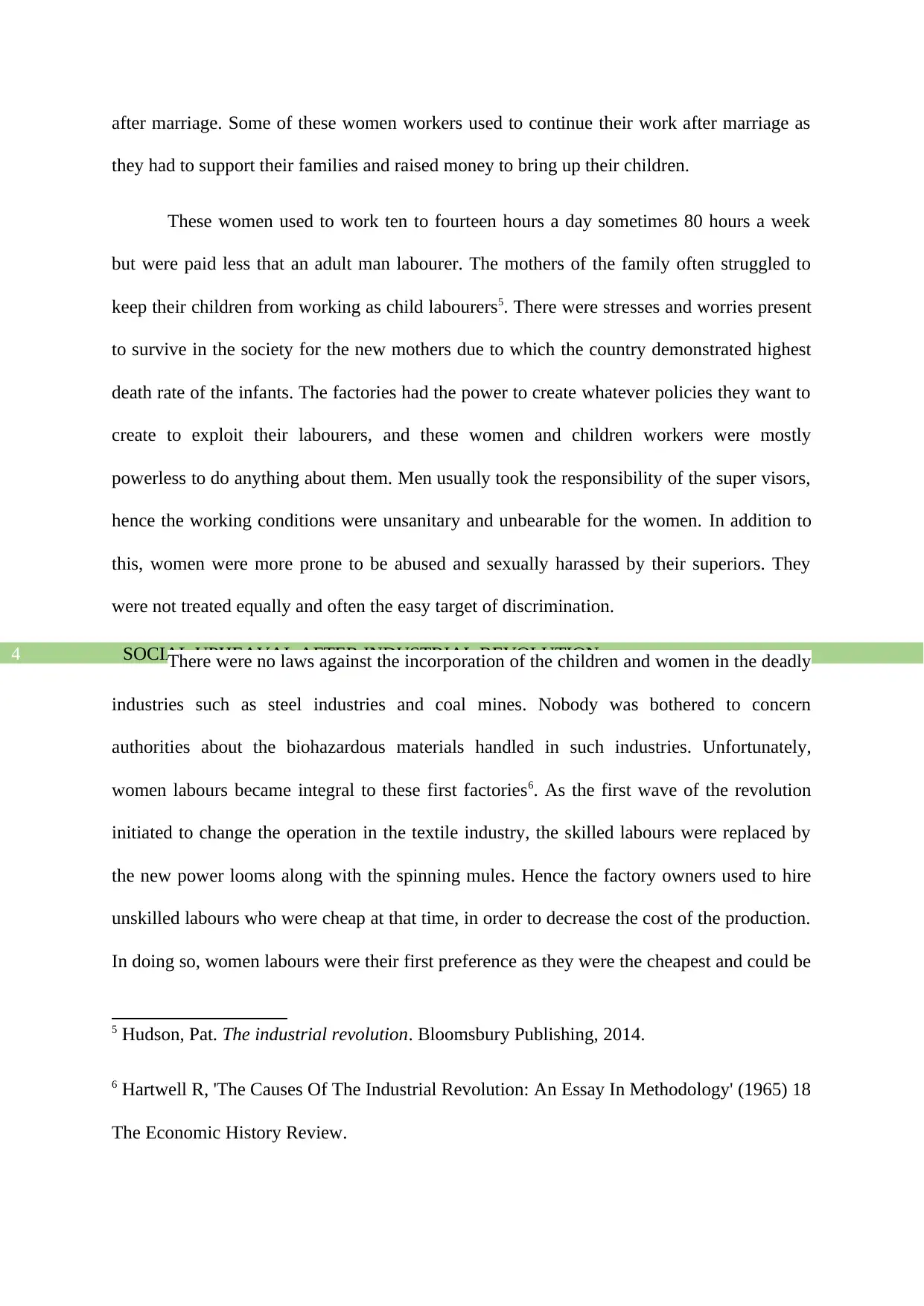
SOCIAL UPHEAVAL AFTER INDUSTRIAL REVOLUTION4
after marriage. Some of these women workers used to continue their work after marriage as
they had to support their families and raised money to bring up their children.
These women used to work ten to fourteen hours a day sometimes 80 hours a week
but were paid less that an adult man labourer. The mothers of the family often struggled to
keep their children from working as child labourers5. There were stresses and worries present
to survive in the society for the new mothers due to which the country demonstrated highest
death rate of the infants. The factories had the power to create whatever policies they want to
create to exploit their labourers, and these women and children workers were mostly
powerless to do anything about them. Men usually took the responsibility of the super visors,
hence the working conditions were unsanitary and unbearable for the women. In addition to
this, women were more prone to be abused and sexually harassed by their superiors. They
were not treated equally and often the easy target of discrimination.
There were no laws against the incorporation of the children and women in the deadly
industries such as steel industries and coal mines. Nobody was bothered to concern
authorities about the biohazardous materials handled in such industries. Unfortunately,
women labours became integral to these first factories6. As the first wave of the revolution
initiated to change the operation in the textile industry, the skilled labours were replaced by
the new power looms along with the spinning mules. Hence the factory owners used to hire
unskilled labours who were cheap at that time, in order to decrease the cost of the production.
In doing so, women labours were their first preference as they were the cheapest and could be
5 Hudson, Pat. The industrial revolution. Bloomsbury Publishing, 2014.
6 Hartwell R, 'The Causes Of The Industrial Revolution: An Essay In Methodology' (1965) 18
The Economic History Review.
after marriage. Some of these women workers used to continue their work after marriage as
they had to support their families and raised money to bring up their children.
These women used to work ten to fourteen hours a day sometimes 80 hours a week
but were paid less that an adult man labourer. The mothers of the family often struggled to
keep their children from working as child labourers5. There were stresses and worries present
to survive in the society for the new mothers due to which the country demonstrated highest
death rate of the infants. The factories had the power to create whatever policies they want to
create to exploit their labourers, and these women and children workers were mostly
powerless to do anything about them. Men usually took the responsibility of the super visors,
hence the working conditions were unsanitary and unbearable for the women. In addition to
this, women were more prone to be abused and sexually harassed by their superiors. They
were not treated equally and often the easy target of discrimination.
There were no laws against the incorporation of the children and women in the deadly
industries such as steel industries and coal mines. Nobody was bothered to concern
authorities about the biohazardous materials handled in such industries. Unfortunately,
women labours became integral to these first factories6. As the first wave of the revolution
initiated to change the operation in the textile industry, the skilled labours were replaced by
the new power looms along with the spinning mules. Hence the factory owners used to hire
unskilled labours who were cheap at that time, in order to decrease the cost of the production.
In doing so, women labours were their first preference as they were the cheapest and could be
5 Hudson, Pat. The industrial revolution. Bloomsbury Publishing, 2014.
6 Hartwell R, 'The Causes Of The Industrial Revolution: An Essay In Methodology' (1965) 18
The Economic History Review.
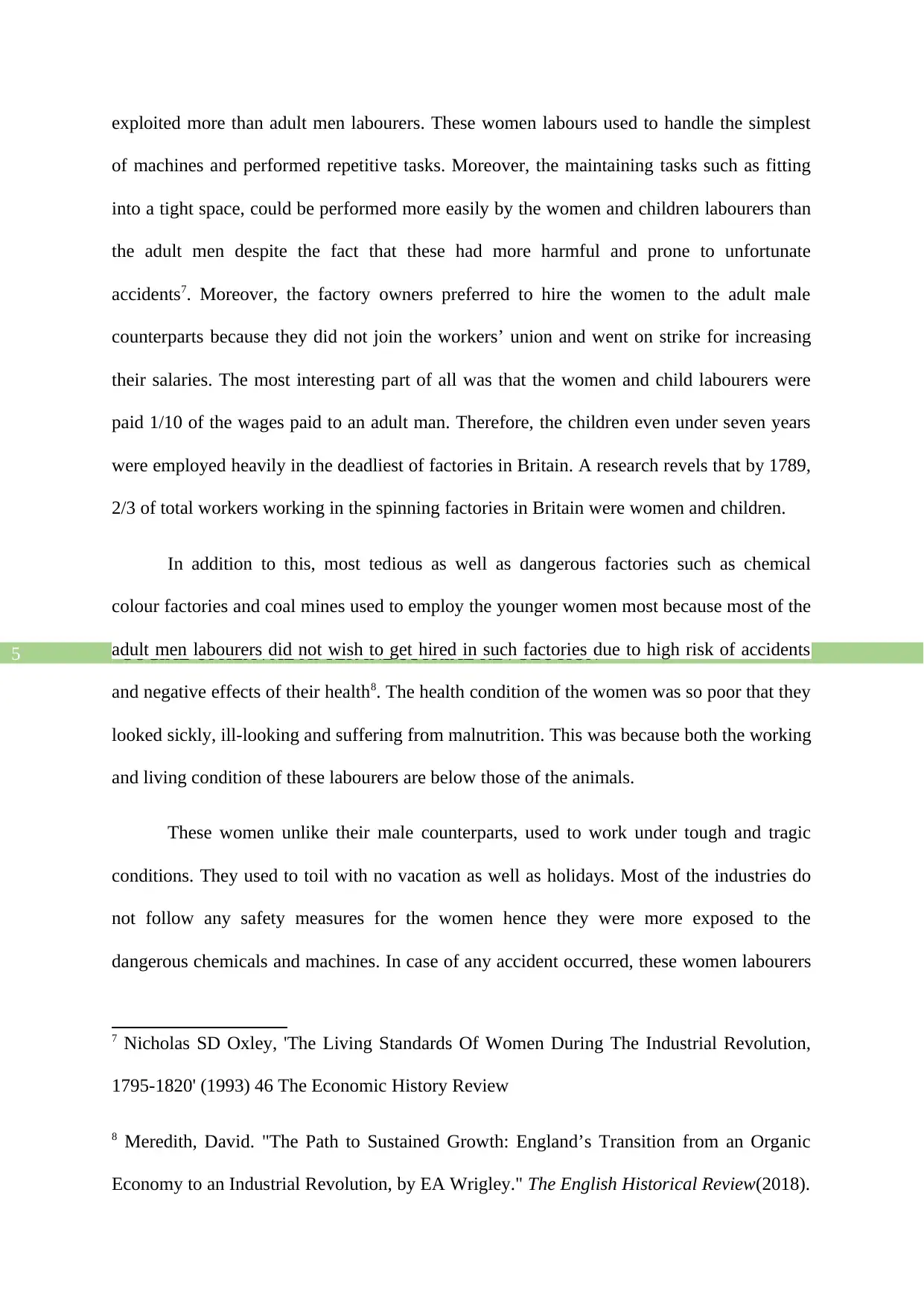
SOCIAL UPHEAVAL AFTER INDUSTRIAL REVOLUTION5
exploited more than adult men labourers. These women labours used to handle the simplest
of machines and performed repetitive tasks. Moreover, the maintaining tasks such as fitting
into a tight space, could be performed more easily by the women and children labourers than
the adult men despite the fact that these had more harmful and prone to unfortunate
accidents7. Moreover, the factory owners preferred to hire the women to the adult male
counterparts because they did not join the workers’ union and went on strike for increasing
their salaries. The most interesting part of all was that the women and child labourers were
paid 1/10 of the wages paid to an adult man. Therefore, the children even under seven years
were employed heavily in the deadliest of factories in Britain. A research revels that by 1789,
2/3 of total workers working in the spinning factories in Britain were women and children.
In addition to this, most tedious as well as dangerous factories such as chemical
colour factories and coal mines used to employ the younger women most because most of the
adult men labourers did not wish to get hired in such factories due to high risk of accidents
and negative effects of their health8. The health condition of the women was so poor that they
looked sickly, ill-looking and suffering from malnutrition. This was because both the working
and living condition of these labourers are below those of the animals.
These women unlike their male counterparts, used to work under tough and tragic
conditions. They used to toil with no vacation as well as holidays. Most of the industries do
not follow any safety measures for the women hence they were more exposed to the
dangerous chemicals and machines. In case of any accident occurred, these women labourers
7 Nicholas SD Oxley, 'The Living Standards Of Women During The Industrial Revolution,
1795-1820' (1993) 46 The Economic History Review
8 Meredith, David. "The Path to Sustained Growth: England’s Transition from an Organic
Economy to an Industrial Revolution, by EA Wrigley." The English Historical Review(2018).
exploited more than adult men labourers. These women labours used to handle the simplest
of machines and performed repetitive tasks. Moreover, the maintaining tasks such as fitting
into a tight space, could be performed more easily by the women and children labourers than
the adult men despite the fact that these had more harmful and prone to unfortunate
accidents7. Moreover, the factory owners preferred to hire the women to the adult male
counterparts because they did not join the workers’ union and went on strike for increasing
their salaries. The most interesting part of all was that the women and child labourers were
paid 1/10 of the wages paid to an adult man. Therefore, the children even under seven years
were employed heavily in the deadliest of factories in Britain. A research revels that by 1789,
2/3 of total workers working in the spinning factories in Britain were women and children.
In addition to this, most tedious as well as dangerous factories such as chemical
colour factories and coal mines used to employ the younger women most because most of the
adult men labourers did not wish to get hired in such factories due to high risk of accidents
and negative effects of their health8. The health condition of the women was so poor that they
looked sickly, ill-looking and suffering from malnutrition. This was because both the working
and living condition of these labourers are below those of the animals.
These women unlike their male counterparts, used to work under tough and tragic
conditions. They used to toil with no vacation as well as holidays. Most of the industries do
not follow any safety measures for the women hence they were more exposed to the
dangerous chemicals and machines. In case of any accident occurred, these women labourers
7 Nicholas SD Oxley, 'The Living Standards Of Women During The Industrial Revolution,
1795-1820' (1993) 46 The Economic History Review
8 Meredith, David. "The Path to Sustained Growth: England’s Transition from an Organic
Economy to an Industrial Revolution, by EA Wrigley." The English Historical Review(2018).
⊘ This is a preview!⊘
Do you want full access?
Subscribe today to unlock all pages.

Trusted by 1+ million students worldwide
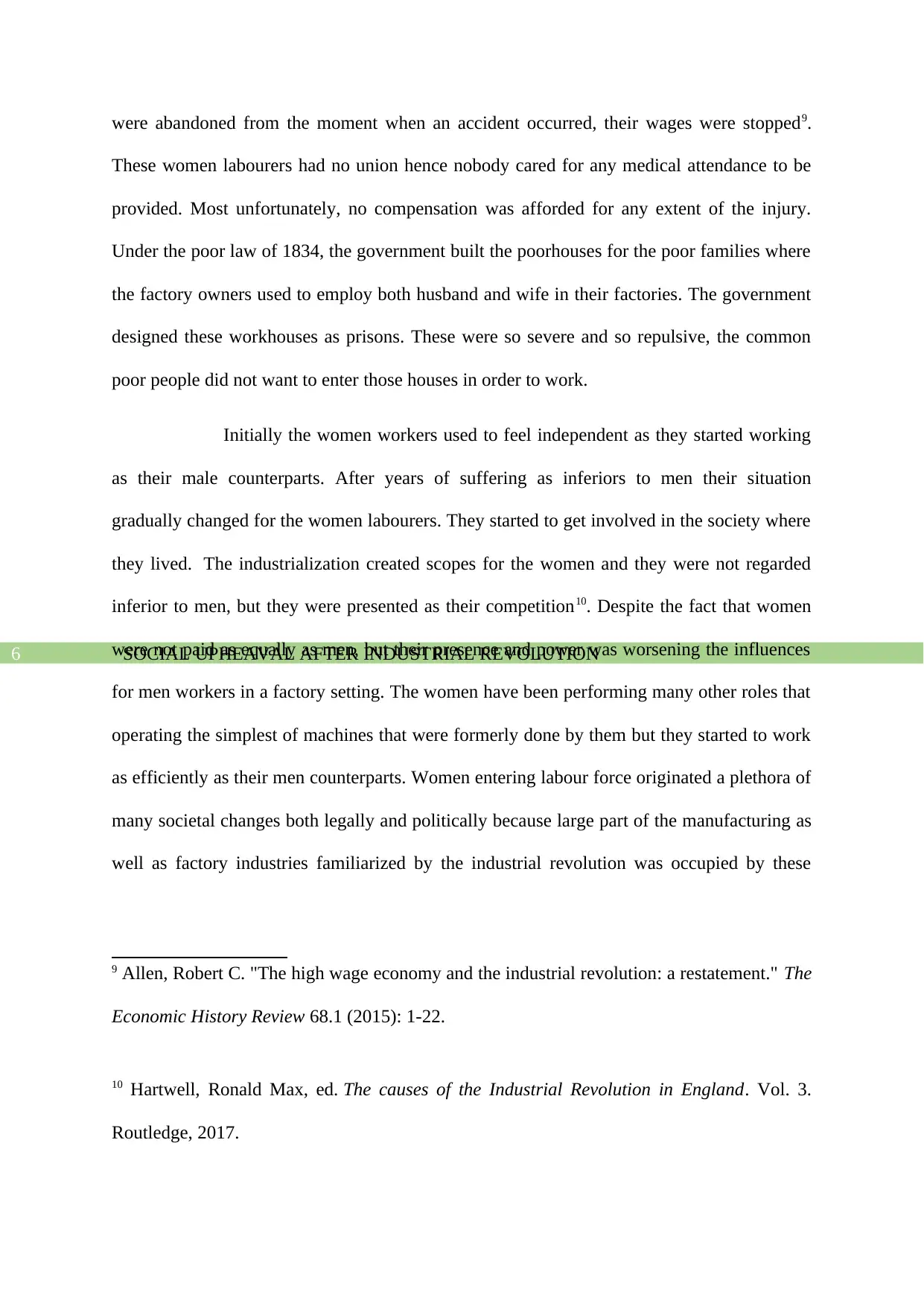
SOCIAL UPHEAVAL AFTER INDUSTRIAL REVOLUTION6
were abandoned from the moment when an accident occurred, their wages were stopped9.
These women labourers had no union hence nobody cared for any medical attendance to be
provided. Most unfortunately, no compensation was afforded for any extent of the injury.
Under the poor law of 1834, the government built the poorhouses for the poor families where
the factory owners used to employ both husband and wife in their factories. The government
designed these workhouses as prisons. These were so severe and so repulsive, the common
poor people did not want to enter those houses in order to work.
Initially the women workers used to feel independent as they started working
as their male counterparts. After years of suffering as inferiors to men their situation
gradually changed for the women labourers. They started to get involved in the society where
they lived. The industrialization created scopes for the women and they were not regarded
inferior to men, but they were presented as their competition10. Despite the fact that women
were not paid as equally as men, but their presence and power was worsening the influences
for men workers in a factory setting. The women have been performing many other roles that
operating the simplest of machines that were formerly done by them but they started to work
as efficiently as their men counterparts. Women entering labour force originated a plethora of
many societal changes both legally and politically because large part of the manufacturing as
well as factory industries familiarized by the industrial revolution was occupied by these
9 Allen, Robert C. "The high wage economy and the industrial revolution: a restatement." The
Economic History Review 68.1 (2015): 1-22.
10 Hartwell, Ronald Max, ed. The causes of the Industrial Revolution in England. Vol. 3.
Routledge, 2017.
were abandoned from the moment when an accident occurred, their wages were stopped9.
These women labourers had no union hence nobody cared for any medical attendance to be
provided. Most unfortunately, no compensation was afforded for any extent of the injury.
Under the poor law of 1834, the government built the poorhouses for the poor families where
the factory owners used to employ both husband and wife in their factories. The government
designed these workhouses as prisons. These were so severe and so repulsive, the common
poor people did not want to enter those houses in order to work.
Initially the women workers used to feel independent as they started working
as their male counterparts. After years of suffering as inferiors to men their situation
gradually changed for the women labourers. They started to get involved in the society where
they lived. The industrialization created scopes for the women and they were not regarded
inferior to men, but they were presented as their competition10. Despite the fact that women
were not paid as equally as men, but their presence and power was worsening the influences
for men workers in a factory setting. The women have been performing many other roles that
operating the simplest of machines that were formerly done by them but they started to work
as efficiently as their men counterparts. Women entering labour force originated a plethora of
many societal changes both legally and politically because large part of the manufacturing as
well as factory industries familiarized by the industrial revolution was occupied by these
9 Allen, Robert C. "The high wage economy and the industrial revolution: a restatement." The
Economic History Review 68.1 (2015): 1-22.
10 Hartwell, Ronald Max, ed. The causes of the Industrial Revolution in England. Vol. 3.
Routledge, 2017.
Paraphrase This Document
Need a fresh take? Get an instant paraphrase of this document with our AI Paraphraser
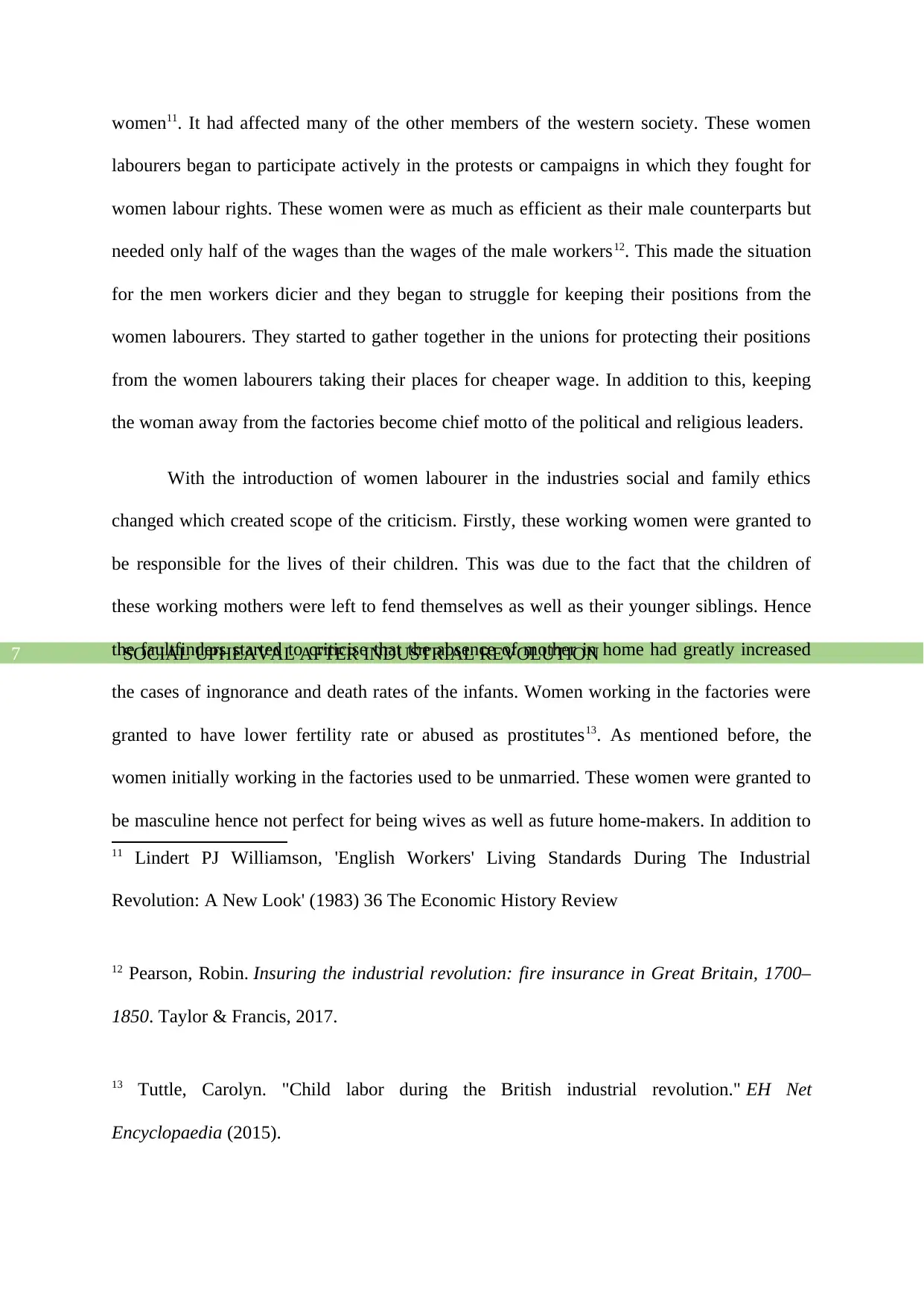
SOCIAL UPHEAVAL AFTER INDUSTRIAL REVOLUTION7
women11. It had affected many of the other members of the western society. These women
labourers began to participate actively in the protests or campaigns in which they fought for
women labour rights. These women were as much as efficient as their male counterparts but
needed only half of the wages than the wages of the male workers12. This made the situation
for the men workers dicier and they began to struggle for keeping their positions from the
women labourers. They started to gather together in the unions for protecting their positions
from the women labourers taking their places for cheaper wage. In addition to this, keeping
the woman away from the factories become chief motto of the political and religious leaders.
With the introduction of women labourer in the industries social and family ethics
changed which created scope of the criticism. Firstly, these working women were granted to
be responsible for the lives of their children. This was due to the fact that the children of
these working mothers were left to fend themselves as well as their younger siblings. Hence
the faultfinders started to criticise that the absence of mother in home had greatly increased
the cases of ingnorance and death rates of the infants. Women working in the factories were
granted to have lower fertility rate or abused as prostitutes13. As mentioned before, the
women initially working in the factories used to be unmarried. These women were granted to
be masculine hence not perfect for being wives as well as future home-makers. In addition to
11 Lindert PJ Williamson, 'English Workers' Living Standards During The Industrial
Revolution: A New Look' (1983) 36 The Economic History Review
12 Pearson, Robin. Insuring the industrial revolution: fire insurance in Great Britain, 1700–
1850. Taylor & Francis, 2017.
13 Tuttle, Carolyn. "Child labor during the British industrial revolution." EH Net
Encyclopaedia (2015).
women11. It had affected many of the other members of the western society. These women
labourers began to participate actively in the protests or campaigns in which they fought for
women labour rights. These women were as much as efficient as their male counterparts but
needed only half of the wages than the wages of the male workers12. This made the situation
for the men workers dicier and they began to struggle for keeping their positions from the
women labourers. They started to gather together in the unions for protecting their positions
from the women labourers taking their places for cheaper wage. In addition to this, keeping
the woman away from the factories become chief motto of the political and religious leaders.
With the introduction of women labourer in the industries social and family ethics
changed which created scope of the criticism. Firstly, these working women were granted to
be responsible for the lives of their children. This was due to the fact that the children of
these working mothers were left to fend themselves as well as their younger siblings. Hence
the faultfinders started to criticise that the absence of mother in home had greatly increased
the cases of ingnorance and death rates of the infants. Women working in the factories were
granted to have lower fertility rate or abused as prostitutes13. As mentioned before, the
women initially working in the factories used to be unmarried. These women were granted to
be masculine hence not perfect for being wives as well as future home-makers. In addition to
11 Lindert PJ Williamson, 'English Workers' Living Standards During The Industrial
Revolution: A New Look' (1983) 36 The Economic History Review
12 Pearson, Robin. Insuring the industrial revolution: fire insurance in Great Britain, 1700–
1850. Taylor & Francis, 2017.
13 Tuttle, Carolyn. "Child labor during the British industrial revolution." EH Net
Encyclopaedia (2015).
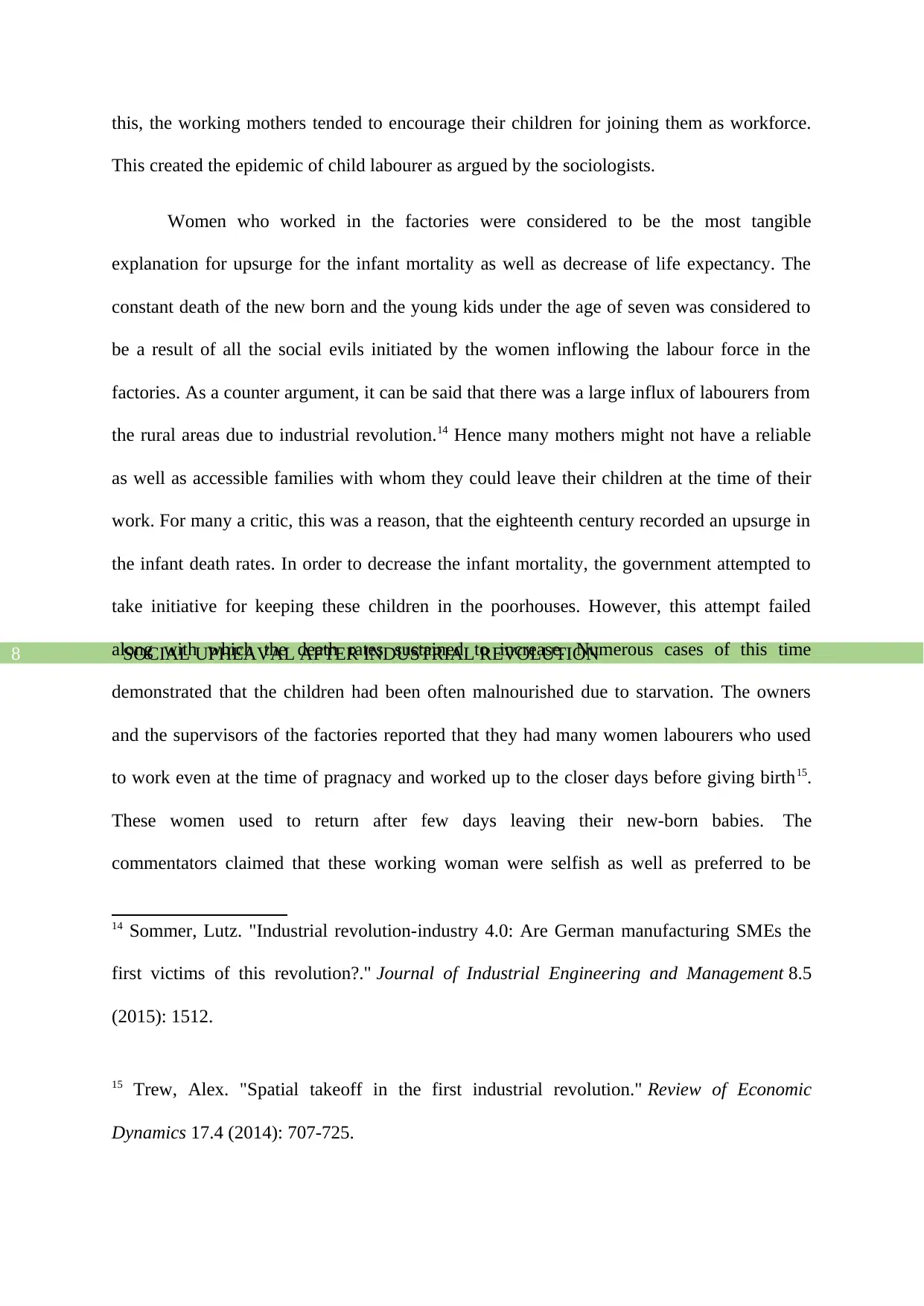
SOCIAL UPHEAVAL AFTER INDUSTRIAL REVOLUTION8
this, the working mothers tended to encourage their children for joining them as workforce.
This created the epidemic of child labourer as argued by the sociologists.
Women who worked in the factories were considered to be the most tangible
explanation for upsurge for the infant mortality as well as decrease of life expectancy. The
constant death of the new born and the young kids under the age of seven was considered to
be a result of all the social evils initiated by the women inflowing the labour force in the
factories. As a counter argument, it can be said that there was a large influx of labourers from
the rural areas due to industrial revolution.14 Hence many mothers might not have a reliable
as well as accessible families with whom they could leave their children at the time of their
work. For many a critic, this was a reason, that the eighteenth century recorded an upsurge in
the infant death rates. In order to decrease the infant mortality, the government attempted to
take initiative for keeping these children in the poorhouses. However, this attempt failed
along with which the death rates sustained to increase. Numerous cases of this time
demonstrated that the children had been often malnourished due to starvation. The owners
and the supervisors of the factories reported that they had many women labourers who used
to work even at the time of pragnacy and worked up to the closer days before giving birth15.
These women used to return after few days leaving their new-born babies. The
commentators claimed that these working woman were selfish as well as preferred to be
14 Sommer, Lutz. "Industrial revolution-industry 4.0: Are German manufacturing SMEs the
first victims of this revolution?." Journal of Industrial Engineering and Management 8.5
(2015): 1512.
15 Trew, Alex. "Spatial takeoff in the first industrial revolution." Review of Economic
Dynamics 17.4 (2014): 707-725.
this, the working mothers tended to encourage their children for joining them as workforce.
This created the epidemic of child labourer as argued by the sociologists.
Women who worked in the factories were considered to be the most tangible
explanation for upsurge for the infant mortality as well as decrease of life expectancy. The
constant death of the new born and the young kids under the age of seven was considered to
be a result of all the social evils initiated by the women inflowing the labour force in the
factories. As a counter argument, it can be said that there was a large influx of labourers from
the rural areas due to industrial revolution.14 Hence many mothers might not have a reliable
as well as accessible families with whom they could leave their children at the time of their
work. For many a critic, this was a reason, that the eighteenth century recorded an upsurge in
the infant death rates. In order to decrease the infant mortality, the government attempted to
take initiative for keeping these children in the poorhouses. However, this attempt failed
along with which the death rates sustained to increase. Numerous cases of this time
demonstrated that the children had been often malnourished due to starvation. The owners
and the supervisors of the factories reported that they had many women labourers who used
to work even at the time of pragnacy and worked up to the closer days before giving birth15.
These women used to return after few days leaving their new-born babies. The
commentators claimed that these working woman were selfish as well as preferred to be
14 Sommer, Lutz. "Industrial revolution-industry 4.0: Are German manufacturing SMEs the
first victims of this revolution?." Journal of Industrial Engineering and Management 8.5
(2015): 1512.
15 Trew, Alex. "Spatial takeoff in the first industrial revolution." Review of Economic
Dynamics 17.4 (2014): 707-725.
⊘ This is a preview!⊘
Do you want full access?
Subscribe today to unlock all pages.

Trusted by 1+ million students worldwide
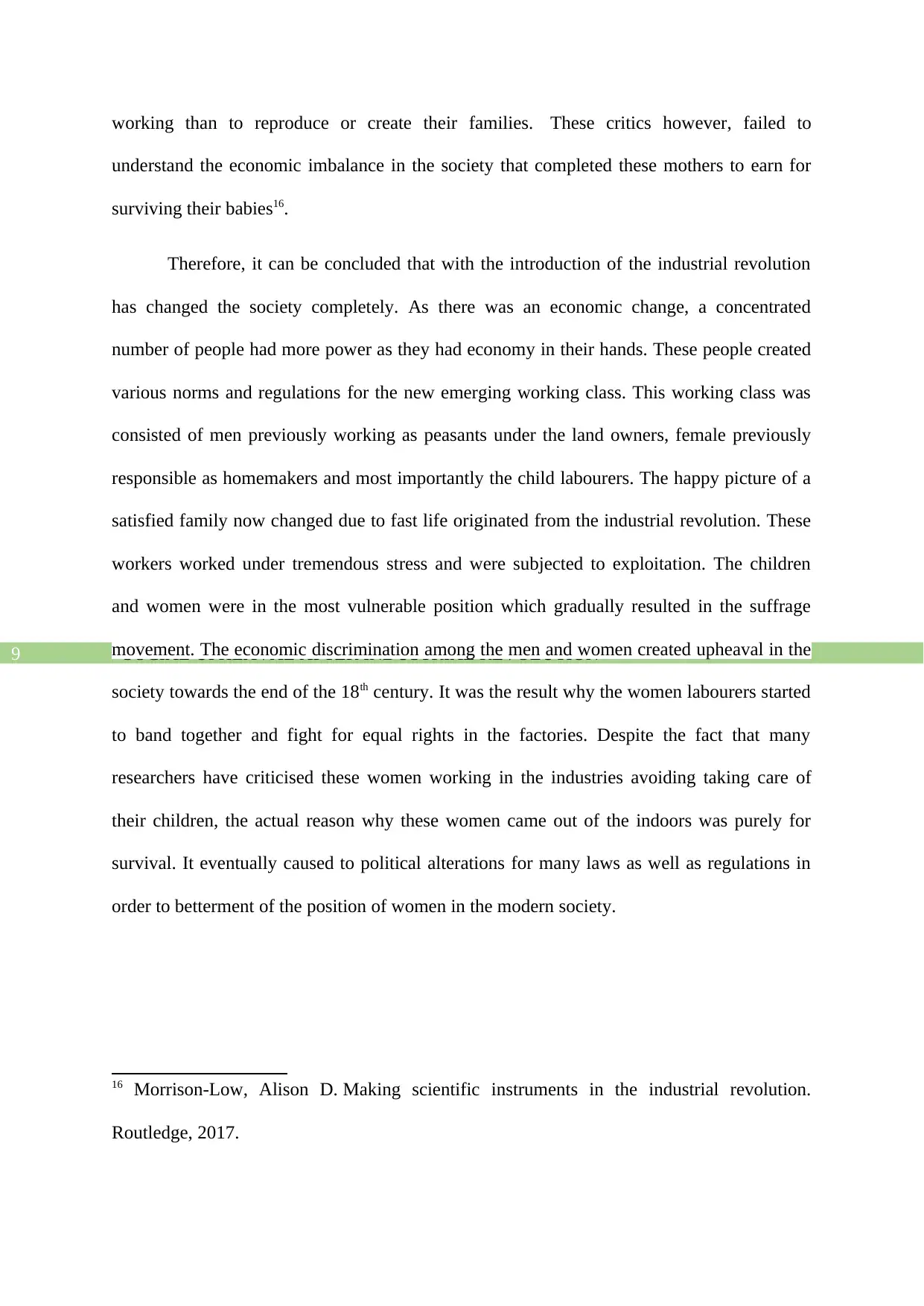
SOCIAL UPHEAVAL AFTER INDUSTRIAL REVOLUTION9
working than to reproduce or create their families. These critics however, failed to
understand the economic imbalance in the society that completed these mothers to earn for
surviving their babies16.
Therefore, it can be concluded that with the introduction of the industrial revolution
has changed the society completely. As there was an economic change, a concentrated
number of people had more power as they had economy in their hands. These people created
various norms and regulations for the new emerging working class. This working class was
consisted of men previously working as peasants under the land owners, female previously
responsible as homemakers and most importantly the child labourers. The happy picture of a
satisfied family now changed due to fast life originated from the industrial revolution. These
workers worked under tremendous stress and were subjected to exploitation. The children
and women were in the most vulnerable position which gradually resulted in the suffrage
movement. The economic discrimination among the men and women created upheaval in the
society towards the end of the 18th century. It was the result why the women labourers started
to band together and fight for equal rights in the factories. Despite the fact that many
researchers have criticised these women working in the industries avoiding taking care of
their children, the actual reason why these women came out of the indoors was purely for
survival. It eventually caused to political alterations for many laws as well as regulations in
order to betterment of the position of women in the modern society.
16 Morrison-Low, Alison D. Making scientific instruments in the industrial revolution.
Routledge, 2017.
working than to reproduce or create their families. These critics however, failed to
understand the economic imbalance in the society that completed these mothers to earn for
surviving their babies16.
Therefore, it can be concluded that with the introduction of the industrial revolution
has changed the society completely. As there was an economic change, a concentrated
number of people had more power as they had economy in their hands. These people created
various norms and regulations for the new emerging working class. This working class was
consisted of men previously working as peasants under the land owners, female previously
responsible as homemakers and most importantly the child labourers. The happy picture of a
satisfied family now changed due to fast life originated from the industrial revolution. These
workers worked under tremendous stress and were subjected to exploitation. The children
and women were in the most vulnerable position which gradually resulted in the suffrage
movement. The economic discrimination among the men and women created upheaval in the
society towards the end of the 18th century. It was the result why the women labourers started
to band together and fight for equal rights in the factories. Despite the fact that many
researchers have criticised these women working in the industries avoiding taking care of
their children, the actual reason why these women came out of the indoors was purely for
survival. It eventually caused to political alterations for many laws as well as regulations in
order to betterment of the position of women in the modern society.
16 Morrison-Low, Alison D. Making scientific instruments in the industrial revolution.
Routledge, 2017.
Paraphrase This Document
Need a fresh take? Get an instant paraphrase of this document with our AI Paraphraser
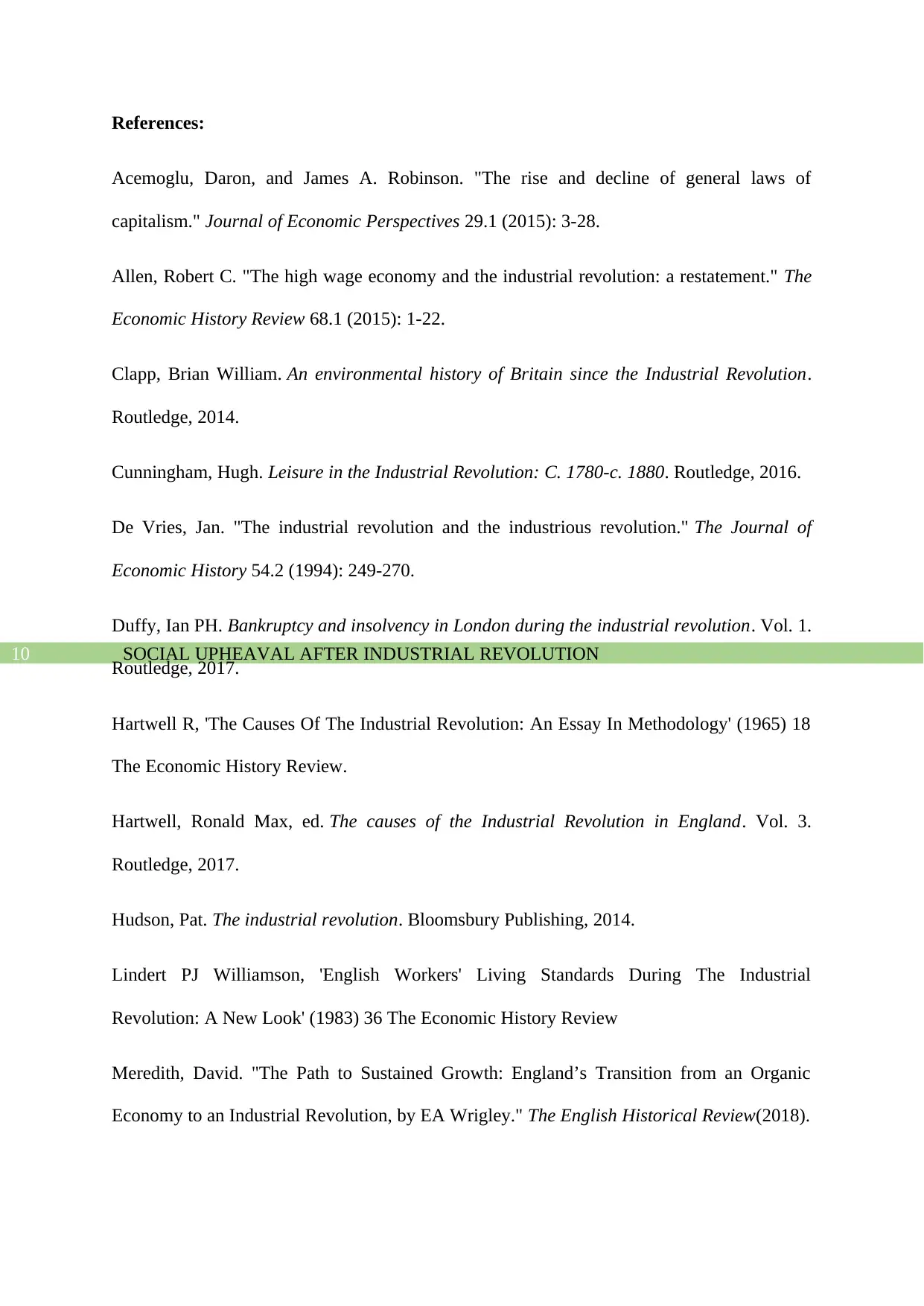
SOCIAL UPHEAVAL AFTER INDUSTRIAL REVOLUTION10
References:
Acemoglu, Daron, and James A. Robinson. "The rise and decline of general laws of
capitalism." Journal of Economic Perspectives 29.1 (2015): 3-28.
Allen, Robert C. "The high wage economy and the industrial revolution: a restatement." The
Economic History Review 68.1 (2015): 1-22.
Clapp, Brian William. An environmental history of Britain since the Industrial Revolution.
Routledge, 2014.
Cunningham, Hugh. Leisure in the Industrial Revolution: C. 1780-c. 1880. Routledge, 2016.
De Vries, Jan. "The industrial revolution and the industrious revolution." The Journal of
Economic History 54.2 (1994): 249-270.
Duffy, Ian PH. Bankruptcy and insolvency in London during the industrial revolution. Vol. 1.
Routledge, 2017.
Hartwell R, 'The Causes Of The Industrial Revolution: An Essay In Methodology' (1965) 18
The Economic History Review.
Hartwell, Ronald Max, ed. The causes of the Industrial Revolution in England. Vol. 3.
Routledge, 2017.
Hudson, Pat. The industrial revolution. Bloomsbury Publishing, 2014.
Lindert PJ Williamson, 'English Workers' Living Standards During The Industrial
Revolution: A New Look' (1983) 36 The Economic History Review
Meredith, David. "The Path to Sustained Growth: England’s Transition from an Organic
Economy to an Industrial Revolution, by EA Wrigley." The English Historical Review(2018).
References:
Acemoglu, Daron, and James A. Robinson. "The rise and decline of general laws of
capitalism." Journal of Economic Perspectives 29.1 (2015): 3-28.
Allen, Robert C. "The high wage economy and the industrial revolution: a restatement." The
Economic History Review 68.1 (2015): 1-22.
Clapp, Brian William. An environmental history of Britain since the Industrial Revolution.
Routledge, 2014.
Cunningham, Hugh. Leisure in the Industrial Revolution: C. 1780-c. 1880. Routledge, 2016.
De Vries, Jan. "The industrial revolution and the industrious revolution." The Journal of
Economic History 54.2 (1994): 249-270.
Duffy, Ian PH. Bankruptcy and insolvency in London during the industrial revolution. Vol. 1.
Routledge, 2017.
Hartwell R, 'The Causes Of The Industrial Revolution: An Essay In Methodology' (1965) 18
The Economic History Review.
Hartwell, Ronald Max, ed. The causes of the Industrial Revolution in England. Vol. 3.
Routledge, 2017.
Hudson, Pat. The industrial revolution. Bloomsbury Publishing, 2014.
Lindert PJ Williamson, 'English Workers' Living Standards During The Industrial
Revolution: A New Look' (1983) 36 The Economic History Review
Meredith, David. "The Path to Sustained Growth: England’s Transition from an Organic
Economy to an Industrial Revolution, by EA Wrigley." The English Historical Review(2018).
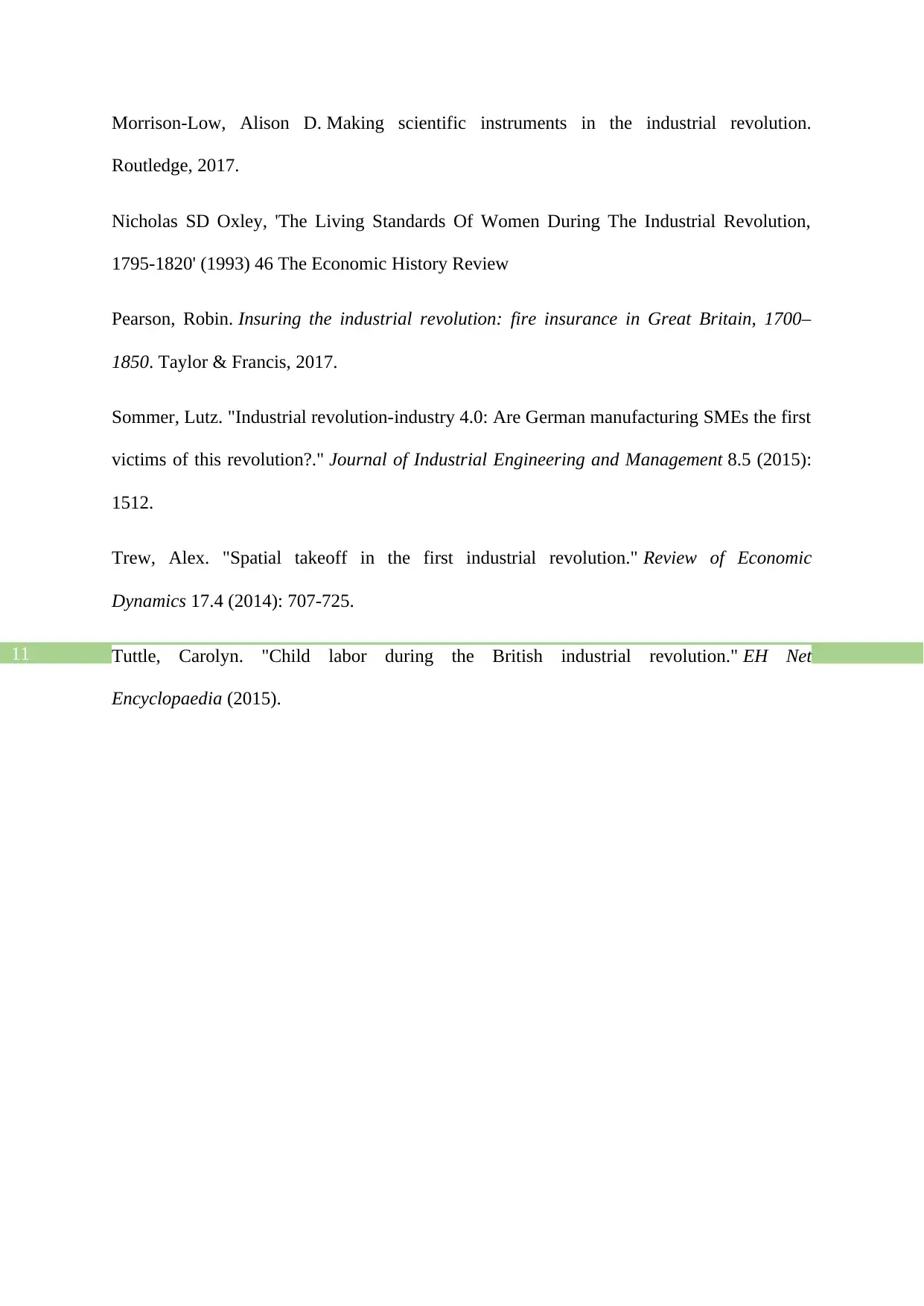
SOCIAL UPHEAVAL AFTER INDUSTRIAL REVOLUTION11
Morrison-Low, Alison D. Making scientific instruments in the industrial revolution.
Routledge, 2017.
Nicholas SD Oxley, 'The Living Standards Of Women During The Industrial Revolution,
1795-1820' (1993) 46 The Economic History Review
Pearson, Robin. Insuring the industrial revolution: fire insurance in Great Britain, 1700–
1850. Taylor & Francis, 2017.
Sommer, Lutz. "Industrial revolution-industry 4.0: Are German manufacturing SMEs the first
victims of this revolution?." Journal of Industrial Engineering and Management 8.5 (2015):
1512.
Trew, Alex. "Spatial takeoff in the first industrial revolution." Review of Economic
Dynamics 17.4 (2014): 707-725.
Tuttle, Carolyn. "Child labor during the British industrial revolution." EH Net
Encyclopaedia (2015).
Morrison-Low, Alison D. Making scientific instruments in the industrial revolution.
Routledge, 2017.
Nicholas SD Oxley, 'The Living Standards Of Women During The Industrial Revolution,
1795-1820' (1993) 46 The Economic History Review
Pearson, Robin. Insuring the industrial revolution: fire insurance in Great Britain, 1700–
1850. Taylor & Francis, 2017.
Sommer, Lutz. "Industrial revolution-industry 4.0: Are German manufacturing SMEs the first
victims of this revolution?." Journal of Industrial Engineering and Management 8.5 (2015):
1512.
Trew, Alex. "Spatial takeoff in the first industrial revolution." Review of Economic
Dynamics 17.4 (2014): 707-725.
Tuttle, Carolyn. "Child labor during the British industrial revolution." EH Net
Encyclopaedia (2015).
⊘ This is a preview!⊘
Do you want full access?
Subscribe today to unlock all pages.

Trusted by 1+ million students worldwide
1 out of 12
Related Documents
Your All-in-One AI-Powered Toolkit for Academic Success.
+13062052269
info@desklib.com
Available 24*7 on WhatsApp / Email
![[object Object]](/_next/static/media/star-bottom.7253800d.svg)
Unlock your academic potential
Copyright © 2020–2025 A2Z Services. All Rights Reserved. Developed and managed by ZUCOL.





